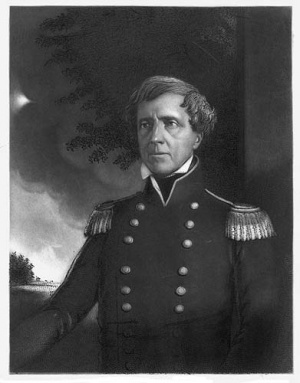Stephen Watts Kearny
|
Stephen Watts Kearny (1794-1848) - born 30 Aug 1794 in Newark New Jersey. Died on 31 Oct 1848 at the home of Major Meriwether Lewis Clark Template:Cullum in the Gateway City, St. Louis, Missouri. Soldier, explorer, builder, writer, and statesman; Kearny commanded the Army of the West, and is called "The Father of the U.S. Cavalry." Kearny's military career began, and nearly ended in the Battle of Queenstown Heights during the War of 1812, when he was wounded and taken prisoner. After Kearny's release, he joined Henry Atkinson on several expeditions of the Missouri and its tributaries, including an exploration trek to the mouth of the Yellowstone River in 1825. Kearny was in the Matthew McGee party, which opened a new trail to Camp Cold Water (now Fort Snelling). Later, Kearny led explorations throughout Iowa and Minnesota. The young soldier helped to locate, build, and command a number of Missouri River and frontier forts. In 1826, he was appointed Commander of the new Jefferson Barracks in Missouri. By 1830, he had Married Mary Radford, Step-daughter of General Clark (of Lewis and Clark fame) and had moved to Fort Leavenworth, where he was charged with protecting the freight and travelers on the Santa Fe, Mormon, and Oregon Trails. In addition to these duties, Kearny published the Manual for the Exercise and Maneuvering of United States Dragoons in 1837. Mexican WarAt the outset of the Mexican War, President Polk asked Kearny to muster an army, and march 1,000 miles into the Southwest in order to claim that region for the United States. Along the way, he was to organize territorial governments. The Mexican administration had been weakened by years of occupation and political turmoil. Some historians suggest that Polk had secretly negotiated the sale of the northern states with a cash poor faction of Mexico's ruling elite, and that some hostilities were contrived at that time to persuade reluctant Senators, and patriotic Mexicans of the inevitable outcome. Perhaps that is why Kearny was able to take the important northern commercial center of Santa Fe without firing a shot. He won over the local leaders, stayed to assure a peaceful transition to a new civilian government, and implemented a new legal code for the territory, before he continued his march into Arizona and California. Kearny's party encountered the famous western scout, Kit Carson, who was returning from California with a message from Lt. Col. John C. Fremont, describing how the territory had been taken by American settlers in the Bear Flag Revolt. Kearny sent 200 of his troops back with the news, before proceeding with 100 men and the Carson party to San Diego as he was ordered. Fremont, who had been involved in the revolt, had overstated its success. Before Kearny's men reached their destination, the trail weary troop encountered a group of angry Californios intent on keeping more US soldiers from entering their homeland. Kearny's weary men were overwhelmed by the primitively armed resistance in the Battle of San Pasqual. Low on supplies and ammunition, several of Kearny's men were killed in skirmishes while awaiting reinforcement from troops under the command of Commodore Stockton and Fremont. After first refusing help, they eventually relented. Despite his serious injuries, Kearny immediately resumed the march to San Diego in pursuit of his mission. Kearny soon discovered that Californios were not his only problem. After a bitter disagreement with Commodore Robert Stockton and Col. Fremont over leadership of the new territory, Kearny served about three months as the military governor of the territory of California . The insubordinate Fremont was count-martialed in Washington D.C.for his actions, but the maps produced by the engineers under Fremont's command had created a following among frontiersmen, and his influential father-in-law, Sen. Thomas Hart Benton, may have prevailed to secure a pardon from Polk. The outcome of the controversial court martial and the politics were a blow to Kearny; He asked for a new command in the war with Mexico. In Vera Cruz, Mexico, Kearny fell ill with yellow fever. He recovered briefly, but died of the illness on 31 Oct 1848 at the home of Major Meriwether Lewis Clark in St. Louis, Missouri. By that next Spring, thousands of gold seeking "Forty-niners" would surge westward from points in that same state, toward a territory Kearny had just secured for the United States. Their paths would converged at a new fort named in the late general's honor, Fort Kearny (1) was the first major stop on the Oregon and California trails. Several place-names in the United States honor Stephen Watts Kearny or his nephew General Philip Kearny (a fellow frontier explorer and Civil War Hero). Father: Philip Kearny III (1733-1798) Mother: Susanna Watts (1750-1823) Marriage:
Children:
Assignments:
Personal Description:
Links: |
